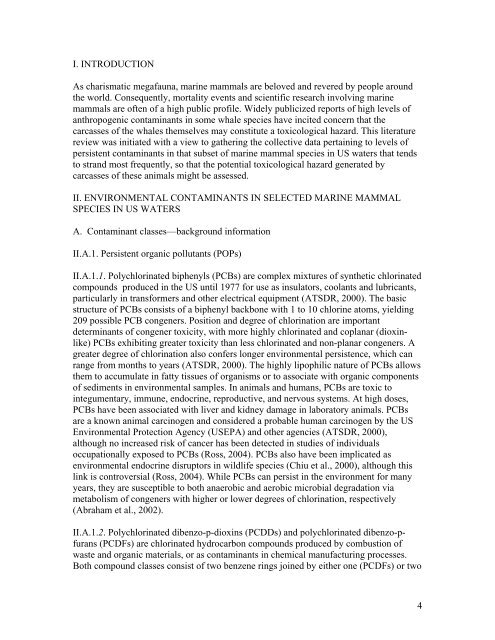Volume III, Appendices EM - National Marine Fisheries Service ...
Volume III, Appendices EM - National Marine Fisheries Service ...
Volume III, Appendices EM - National Marine Fisheries Service ...
You also want an ePaper? Increase the reach of your titles
YUMPU automatically turns print PDFs into web optimized ePapers that Google loves.
I. INTRODUCTION<br />
As charismatic megafauna, marine mammals are beloved and revered by people around<br />
the world. Consequently, mortality events and scientific research involving marine<br />
mammals are often of a high public profile. Widely publicized reports of high levels of<br />
anthropogenic contaminants in some whale species have incited concern that the<br />
carcasses of the whales themselves may constitute a toxicological hazard. This literature<br />
review was initiated with a view to gathering the collective data pertaining to levels of<br />
persistent contaminants in that subset of marine mammal species in US waters that tends<br />
to strand most frequently, so that the potential toxicological hazard generated by<br />
carcasses of these animals might be assessed.<br />
II. ENVIRONMENTAL CONTAMINANTS IN SELECTED MARINE MAMMAL<br />
SPECIES IN US WATERS<br />
A. Contaminant classes—background information<br />
II.A.1. Persistent organic pollutants (POPs)<br />
II.A.1.1. Polychlorinated biphenyls (PCBs) are complex mixtures of synthetic chlorinated<br />
compounds produced in the US until 1977 for use as insulators, coolants and lubricants,<br />
particularly in transformers and other electrical equipment (ATSDR, 2000). The basic<br />
structure of PCBs consists of a biphenyl backbone with 1 to 10 chlorine atoms, yielding<br />
209 possible PCB congeners. Position and degree of chlorination are important<br />
determinants of congener toxicity, with more highly chlorinated and coplanar (dioxinlike)<br />
PCBs exhibiting greater toxicity than less chlorinated and non-planar congeners. A<br />
greater degree of chlorination also confers longer environmental persistence, which can<br />
range from months to years (ATSDR, 2000). The highly lipophilic nature of PCBs allows<br />
them to accumulate in fatty tissues of organisms or to associate with organic components<br />
of sediments in environmental samples. In animals and humans, PCBs are toxic to<br />
integumentary, immune, endocrine, reproductive, and nervous systems. At high doses,<br />
PCBs have been associated with liver and kidney damage in laboratory animals. PCBs<br />
are a known animal carcinogen and considered a probable human carcinogen by the US<br />
Environmental Protection Agency (USEPA) and other agencies (ATSDR, 2000),<br />
although no increased risk of cancer has been detected in studies of individuals<br />
occupationally exposed to PCBs (Ross, 2004). PCBs also have been implicated as<br />
environmental endocrine disruptors in wildlife species (Chiu et al., 2000), although this<br />
link is controversial (Ross, 2004). While PCBs can persist in the environment for many<br />
years, they are susceptible to both anaerobic and aerobic microbial degradation via<br />
metabolism of congeners with higher or lower degrees of chlorination, respectively<br />
(Abraham et al., 2002).<br />
II.A.1.2. Polychlorinated dibenzo-p-dioxins (PCDDs) and polychlorinated dibenzo-pfurans<br />
(PCDFs) are chlorinated hydrocarbon compounds produced by combustion of<br />
waste and organic materials, or as contaminants in chemical manufacturing processes.<br />
Both compound classes consist of two benzene rings joined by either one (PCDFs) or two<br />
4
















